Best Overview to Preventing Weld Undercut: Tips and Techniques
Best Overview to Preventing Weld Undercut: Tips and Techniques
Blog Article
A Comprehensive Overview to Identifying, Fighting, and Fixing Undercut Welding Problems in Your Welding Tasks
In the realm of welding, coming across undercut concerns is a typical obstacle that can jeopardize the architectural stability and total top quality of your welding jobs. Keep tuned as we discover the crucial elements of determining, avoiding, and fixing undercut welding troubles, providing you with beneficial insights and strategies to elevate your welding abilities to the following level.
Typical Reasons For Undercut Welding
Undercut welding, a common concern in welding processes, can be triggered by numerous factors that need to be very carefully recognized and addressed to make certain the stability of the weld joint. One of the primary reasons of undercut welding is extreme warm input. When the welding specifications, such as voltage, present, or take a trip rate, are not effectively established, an excessive amount of warm can be generated. This excess warm brings about the melting and succeeding removal of the base material along the edges of the weld joint, producing a groove called undercut.
One more usual reason for undercut welding is improper welding method. Inadequate control of the welding torch or gun, inaccurate angle or range in between the torch and the work surface, or irregular travel rate can all contribute to the formation of undercut. Furthermore, making use of the incorrect welding consumables or electrode dimension for a certain joint setup can result in undercut issues. Recognizing these source and executing restorative procedures is important in avoiding and remedying undercut welding issues in welding projects.
Identifying Undercut in Welds

To recognize undercut properly, correct lights and magnifying devices are necessary to check the weld joint thoroughly. Using tools such as a welding scale or a magnifying glass can help in identifying even the smallest undercut blemishes. Furthermore, running a finger or a fingernail along the weld joint can occasionally expose undercut, as the surface might feel uneven or have a dip where the undercut exists.
Safety Nets for Undercut
Having a deep understanding of the reasons of undercut in welds allows for the application of reliable preventive procedures to keep weld high quality and stability. These setups ought to be enhanced to stop excessive warm input, which can lead to undercut development.

Strategies for Repairing Undercut

To deal with undercut issues successfully, welders can use specific strategies targeted at correcting the flaw and bring back the stability of the weld joint. One strategy is to change the welding parameters, such as the voltage, current, and take a trip rate, to guarantee proper warm input and fusion. Boosting the welding existing or lowering the traveling speed can help complete the undercut. In addition, transforming the welding method from a push to a drag or vice versa can also aid decrease undercut.
An additional method is to utilize a weaving motion while welding to make sure correct sidewall blend and fill in the undercut. By oscillating the welding arc from side to side within the weld joint, the welder can transfer much more filler product right into the undercut areas, effectively eliminating the issue.
In addition, grinding out the undercut and rewelding the joint can be a feasible remedy for more severe undercut issues - Preventing weld undercut. This procedure involves removing the undercut area, preparing the base steel, and after that rewelding the joint with appropriate welding specifications and strategies to avoid undercut from persisting

Expert Tips for Avoiding Undercut
Using proper welding methods and maintaining control over vital welding criteria are vital methods for welders intending to prevent undercut in their weld joints. In addition, selecting the proper welding go now process and filler metal for the particular application can assist protect against undercut. Maintaining a consistent traveling speed throughout the welding procedure is another crucial suggestion to prevent undercut.
Verdict
Finally, determining, avoiding, and taking care of undercut welding issues in your welding jobs is important for guaranteeing strong and durable welds. Preventing weld undercut. By comprehending the common root causes of undercut, being able to determine it in welds, implementing safety nets, and making use of correct strategies for taking care of undercut, you can prevent potential issues and produce premium welds. Following professional pointers for staying clear of undercut can help you improve your welding skills and generate far better lead to your jobs
Undercut welding, an usual problem in welding procedures, can be caused by different aspects that require to be thoroughly determined and dealt with to ensure the integrity of the weld joint. Furthermore, running a finger or a finger nail along the weld joint can often disclose undercut, as the surface area may feel irregular or have a dip where the undercut exists.
Making use of proper welding techniques and keeping control over essential welding specifications are crucial approaches for welders aiming to stop undercut in their weld joints.In verdict, determining, protecting against, and dealing with undercut welding problems in your welding tasks is essential for making sure durable and strong welds. By comprehending the usual causes of undercut, being able to recognize it in welds, implementing preventative steps, and utilizing correct methods for dealing with undercut, you can prevent prospective concerns and the original source produce high-quality welds.
Report this page